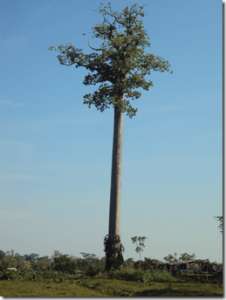Today we took our first trip to Barro Colorado Island! The island was created when the Chagres River was dammed in preparation for the Panama Canal. It then became a nature reserve and since then, the island has flourished with countless species of animals, insects and a wide variety of plant species. Work has been done on the island for nearly a decade and still continues to be done today. Researchers come from all over the world to study the immense biodiversity on Barro Colorado.

The base of a Cuipo tree is often swollen with long roots spreading across the jungle floor.
The morning began with a boat ride to the island with views straight out of Jurassic Park. Breakfast was served there followed by a brief introduction presentation. We then set out on a 3-hour hike through the jungle in search of whatever we could find. Throughout the hike, my group saw a wide range of animals that can be found all over the island. These included a poison dart frog, agoutis, a tarantula, howler monkeys and capuchins as well as a long list of different bird species. We also stopped to look at some of the various plant species that can be found on the island including various species of palm trees, the Panama tree, and the Cuipo tree.
The Cuipo tree was easily the thickest tree I had ever seen and probably will ever see in my life. Early in the hike, we saw our first Cuipo tree. Our guide told us that the tree was only a juvenile which shocked everyone due to the massive size of it. Later in the hike, we saw another one
which we were told was an adult tree. An indication of how old the tree is can be found by knocking on the trunk of the tree. If the sound is hollow, the tree is younger but if not, the tree is older in age. Our guide informed us that this was because the inside of the tree is spongy when it is young and as it gets older, the inside hardens making the tree thicker so there is no hollow sound that follows a knock. Once we returned from BCI, I was interested to learn more about this fascinating tree species.
Populations of the Cuipo tree have been suffering for years due to the frequent harvest of them. Most commonly, the trunks of the trees are used for canoes or sometimes rope (Biodiversity catalog, n.d). Now that the tree is being seen as threatened, it is even more illegal than it already was to be cutting them down. According to our guide, there are many issues with getting people to obey this law. The tree also has many edible components to it. It the root is cut off, the water stored in them can be consumed as well as the seeds from the tree (Cuipo tree – Wilderness Arena
Survival, 2012).
I am excited to see what else this trip has in store for us and for all the incredible tropical species we will encounter!
References:
-Biodiversity catalog. (n.d.). . http://www.ecologic.org/species/cuipo-2/.
-Cuipo tree – Wilderness Arena Survival. 2012, May 11. . http://wildernessarena.com/food-water-shelter/food-food-water-shelter/food-procurement/edible-wild-plants/cuipo-tree.


I used to see an occasional cuipoo from train trips across the isthmus of Panama.